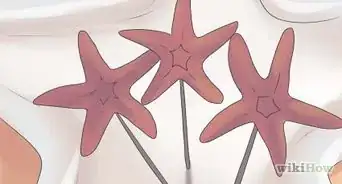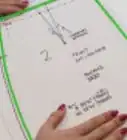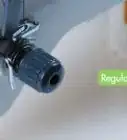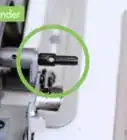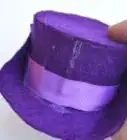This article was co-authored by wikiHow Staff. Our trained team of editors and researchers validate articles for accuracy and comprehensiveness. wikiHow's Content Management Team carefully monitors the work from our editorial staff to ensure that each article is backed by trusted research and meets our high quality standards.
There are 10 references cited in this article, which can be found at the bottom of the page.
The wikiHow Video Team also followed the article's instructions and verified that they work.
This article has been viewed 222,053 times.
Learn more...
Dog fur has been used to make a soft and warm yarn, or Chiengora, throughout history. Much like other yarns, the process for making dog fur yarn involves harvesting the fibers, washing the fur, and spinning it into the yarn. Dogs with long fur undercoats are the best candidates for making dog yarn, and many groomers will donate their extra fur to you if you don’t have a dog of your own!
Steps
Collecting Dog Fur
-
1Brush your dog in the spring, when they’re getting rid of their winter coat. Dogs tend to shed more during the springtime, which makes this a great time for harvesting fur. Use a brush or mitt along the dog’s back, sides, and soft, fluffy areas, and avoid areas like the legs and head. Discard any coarse hairs that you can see in the brush, since you won’t be using them.[1]
- Breeds like Samoyed, Siberian Husky, Malamute, Golden Retriever, Newfoundland, Collie, and Sheepdog are great for making dog yarn because they have fluffy undercoats with long fur.
-
2Pull the fur out of the brush and place it in a cloth bag. Once you’ve picked out the coarse hairs, use your hand to carefully tug the fur out of the brush and transfer it to a bag. Leave the bag open to allow air circulation, preventing mold and mildew.[2]
- If you don’t have a cotton bag, you can use a pillowcase or even a cardboard box for collecting the fur.
- Avoid using a plastic bag for collecting the fur since plastic can trap air and allow mold growth.
- Don’t overfill the bag or push the fur down into the bag. Packing the fur too tightly can cause mold and mildew to form.
Advertisement -
3Make sure you have at least 4 oz (113 g) of fur. To make any type of yarn, you need a substantial amount of fur. After each collection, use a kitchen scale to weigh all of your yarn to see how much you have. If the fur is thin or short, you might need up to 12 oz (339 g) of fur to get the yarn started.[3]
- Keep your bags of fur in a place where your dog can’t get into them, since some dogs like to play with their own fur!
-
4Add other types of fibers and fur to make a blended yarn. If you want to make yarn with a variety of textures, you can incorporate wool from a llama or alpaca, or you can harvest fur from different types of dogs. If you don’t have enough fur, or your pet’s fur is shorter than 2 inches (5.1 cm) long, you can use these different fibers to make a stronger, longer strand of yarn.[4]
- If your dog doesn’t produce a lot of fur, contact a groomer to see if you can use the excess fur from those dogs, or offer to brush a family member’s dog or a friend’s dog to gather additional fur.
- The wool and fur might be a slightly different texture, but that’s okay. As long as you aren’t using coarse hair, the fibers can be blended together through a process called carding.
Washing the Fur
-
1Mix warm water and soap in a large bowl. Drip 2-3 drops of gentle dish soap or pet shampoo into a bowl and turn on the warm water. Swish the water around with your hand to make sure it’s an even temperature, and scoop out any bubbles that raise over the top of the bowl.[5]
- Too many bubbles can make the fur difficult to rinse, but you do need soap to make the fur clean.
-
2Submerge the fur in the water for 10 minutes. Gather the fur and push it down into the water until all of the fibers are completely immersed. Press down on the fur, but don’t tug or pull at it, as this can break the fibers of the fur. Leave the fur in the water to soak out the dirt and debris.[6]
- Try to keep the water at around the same temperature to prevent the fur from becoming matted, which is also called “felting.”
-
3Remove the fur from the water and refill the bowl with warm water. Use your hand to scoop all of the fur out of the bowl and then dump out the water. Make the new water about the same temperature as the previous water, and make sure there are little to no bubbles in the water.[7]
- If there are bubbles in the water, dump the water down the drain and refill the bowl to rinse it.
-
4Place the fur in the water and push it down to remove excess soap. Transfer the fur back into the bowl and push it down to squeeze out the soap and any additional debris. If the fur is very soapy, you may need to give it an extra rinse with fresh, warm water.[8]
- Avoid pulling or wringing the fur in the water, as this can break the fibers and cause the fur to become matted as it dries.
-
5Spread the fur out in the sun to dry for 1-2 hours. Lay down a towel or a mesh screen and position the fur on top of it. Try to spread the fur out as much as possible without breaking it up into small pieces. If there’s wind, place a mesh screen or towel on top of the fur to hold it in place.[9]
- If it’s cloudy or rainy outside, leave the fur inside to dry in a well-ventilated area. It may take up to 4 hours for the fur to dry inside.
Spinning the Yarn
-
1Card the fur using the same process that you would for wool. Using a pair of hand-carders, place the clean and dry fur in sections on one of the carders. Then, roll and pull the empty carder over the one with the fur in a downward motion 2-3 times to elongate the fur. Continue until the fur is soft and evenly blended,[10]
- If you’re blending another type of fiber with the fur, such as alpaca and wool, you can add it in this step by placing it on top of the dog fur in the carder before you begin blending. This will combine the fibers into longer pieces and make them easier to spin.
-
2Remove the fur from the carder and roll it into a roll egg. Use your hands or a removal tool to reach underneath the fur on the carder and lift it off of the wires. Once all of the fur is completely off, place the blended fur on a flat surface and use your hands to roll the fur in one direction, forming a kind of tube or cylinder out of the fur.[11]
- This incorporates the fibers in different directions, making it easier to form yarn, especially when you’re using blended fibers from different sources, like wool and dog fur or different types of dog fur.
-
3Use a drop spindle to easily make a long strand of yarn. Hook the end of your carded and rolled fur onto the end of the spindle and hold the fur in one of your hands. Then, spin the bottom of the spindle and draw the fibers out of the rolled ball of fur. This will create a long strand of yarn from the fur.[12]
- If your fibers are very short and you didn’t blend them with another type of fiber, you may find that they aren’t strong enough to hold the spindle up. In this case, you should try hand-spinning the fur to make your yarn.
-
4Hand-spin the fur if you don’t have a spindle. Hold the fur in one of your hands, and pinch one end into a point. Then, using the opposite hand, begin twisting and slowly drawing the fur out of your hand. Keep twisting it to make it tight and dense until you have a long strand of yarn.[13]
- This method produces shorter, more dense strands of yarn that are good for hats and other small items.
-
5Make cozy crafts out of your new dog fur yarn. Try your hand at knitting and crocheting with your new yarn. Dog yarn is soft and warm, and it easily repels water, so try making a hat or scarf with the yarn. You can even make a pair of socks or gloves to keep yourself warm![14]
- If you have a lot of yarn from the fur, you can make a sweater or a blanket.
-
6Store the yarn in a dry, well-ventilated area. Even when the yarn is made, the dog fur might still be susceptible to mold and mildew if it gets wet. When you aren’t using the bundles of yarn, keep them somewhere dry with good air circulation. If you have to put the yarn in a bag to store it, use a bag made of a breathable fabric, like cotton.[15]
- Try to keep the yarn out of reach of pets, since they may still be able to smell some of their own scent on the fibers and might want to play with the bundles of yarn!
Community Q&A
-
QuestionWhy do you make dog hair yarn?
 Community AnswerDogs shed great amounts of fur that floats around beneath and behind furniture on hardwood floor. It is readily available to dog owners or dog groomers. Why not spin it into yarn instead of filling up trash bags or allowing it to pick up dirt, dust-balls, bugs and bacteria lurking in our homes? Once you turn it into yarn, you can make rugs, hats, sweaters, scarves, booties for your own use or give as hand-made gifts. You can wash it with regular shampoo and conditioner to soften it and make it smell good.
Community AnswerDogs shed great amounts of fur that floats around beneath and behind furniture on hardwood floor. It is readily available to dog owners or dog groomers. Why not spin it into yarn instead of filling up trash bags or allowing it to pick up dirt, dust-balls, bugs and bacteria lurking in our homes? Once you turn it into yarn, you can make rugs, hats, sweaters, scarves, booties for your own use or give as hand-made gifts. You can wash it with regular shampoo and conditioner to soften it and make it smell good. -
QuestionAre there are any tricks for spinning Chihuahua hair? My girl's hair is exactly 1-inch long. Are there any non-animal blending options? Too much cruelty with wool, cashmere, etc.
 Community AnswerThere are several plant-based options including hemp, bamboo, flax, and ramie. But you don't have to discount animal options, local farmers and yarn/fiber events are great sources of humane wool. You're bound to find many small scale vendors dedicated to the well-being of their animals.
Community AnswerThere are several plant-based options including hemp, bamboo, flax, and ramie. But you don't have to discount animal options, local farmers and yarn/fiber events are great sources of humane wool. You're bound to find many small scale vendors dedicated to the well-being of their animals. -
QuestionCan I make cat yarn, too?
 Community AnswerYes, you can spin yarn from any kind of fiber, even cat hair! Just use the same method you would use for dog hair.
Community AnswerYes, you can spin yarn from any kind of fiber, even cat hair! Just use the same method you would use for dog hair.
Warnings
- Keep in mind that some people are allergic to dogs and shouldn’t wear items that have been made from dog fur, even if it has been washed.⧼thumbs_response⧽
Things You'll Need
- Brush or mitt
- Dog fur
- Cotton bag, pillowcase, or box
- Large bowl
- Dish soap
- Water
- Towel or mesh screen
- Hand carders
- Wool or alpaca (optional, for added length/strength)
- Drop spindle (optional)
References
- ↑ https://animals.mom.me/can-i-make-yarn-from-pet-hair-572.html
- ↑ https://animals.mom.me/can-i-make-yarn-from-pet-hair-572.html
- ↑ https://animals.mom.me/can-i-make-yarn-from-pet-hair-572.html
- ↑ https://animals.mom.me/can-i-make-yarn-from-pet-hair-572.html
- ↑ https://youtu.be/nXoLDatucRI?t=36
- ↑ https://youtu.be/nXoLDatucRI?t=48
- ↑ https://youtu.be/nXoLDatucRI?t=103
- ↑ https://youtu.be/nXoLDatucRI?t=149
- ↑ https://youtu.be/nXoLDatucRI?t=281
- ↑ https://animals.mom.me/how-to-make-yarn-from-the-hair-of-a-husky-dog-12544667.html
- ↑ https://youtu.be/SEupQ0PDfFw?t=418
- ↑ https://youtu.be/bKAJTKvl0nE?t=47
- ↑ https://youtu.be/_KxN8DJ9l48?t=597
- ↑ https://animals.mom.me/how-to-make-yarn-from-the-hair-of-a-husky-dog-12544667.html
- ↑ https://animals.mom.me/can-i-make-yarn-from-pet-hair-572.html





